Конспект урока для 11 класса "Проблемы экологии"
Урок-проект по теме «Проблемы экологии» (11 класс)
Учитель английского языка Болдырева Ольга Ивановна
Цель: активизация речевой и мыслительной деятельности учащихся
Задачи:
Ознакомить учащихся с проблемами экологии в мире
Совершенствовать навыки устной речи, аудирования, развивать умение владения английским языком в обсуждении экологических проблем
Развивать умения анализировать, сравнивать, сопоставлять и делать выводы
Воспитывать чувство любви к своему родному краю, бережное отношение к природе и чувство ответственности за свои поступки
Оборудование: карты мира, мультимедийный проектор, компьютер
Ход урока:
Вступительное слово учителя.
Today it is an unusual lesson. This lesson will be taught with the help of students.
Now we’ll begin our lesson with a song. Listen to it and say what it is about.
(звучит песня об экологических проблемах)
Slide 1: Mankind believed for a long time that whatever we did, the Earth would remain the same. We know now that it isn’t true. There are a lot of problems that people face nowadays. But the most urgent problem concerning people of the world is an ecological one.
What is ecology? Ecology is the science that studies the conditions of the habitat of man, animals and plants.
Nowadays people understand how important it is to solve the environmental problems. The most serious environmental problems are:
pollution in its many forms (e. g. water pollution, air pollution)
noise from transport
destruction of countryside beauty
growth of population
acid rain
deforestation and others
Well, today we’ll discuss some of the ecological problems and try not only to focus on them, but to think about the ways of their solutions.
Обсуждение проекта.
Ученики защищают проект по темам:
Water Pollution
Air Pollution
Deforestation
Destruction of Wildlife
Destruction of the Ozone Layer
Ecological Organizations
После выступления учеников по данным темам остальные учащиеся задают вопросы по прослушанному материалу и делают выводы о способах решения данных проблем.
Заключительное слово учителя. Подведение итогов.
Учащиеся еще раз обращают внимание на главные экологические проблемы и пути их решения.
Well, students, it’s time to finish our lesson. It was great pleasure to discuss ecological problems with you.
In a world, it’s time to take care of our nature like a mother takes care of her only child. I want to say that there are many actions that each person can take every day. Think globally – act locally!
Save our environment!
Приложение (выступления учащихся):
Air pollution
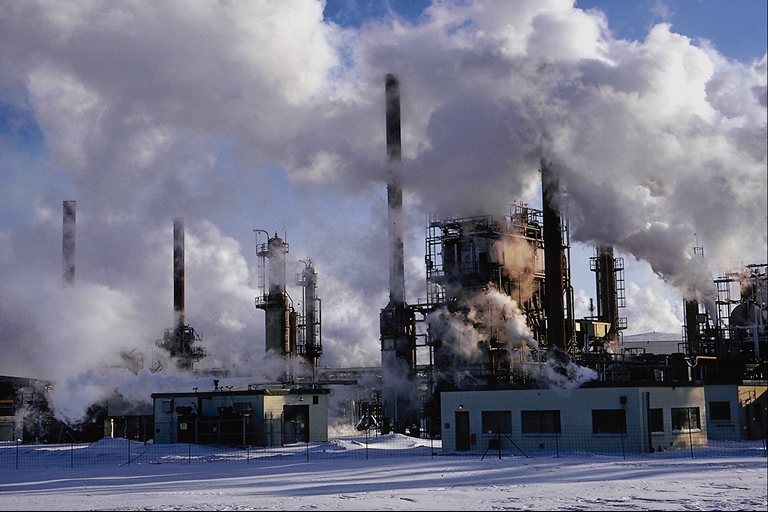
Air pollution is the introduction into the atmosphere of chemicals, particulates, or biological materials that cause discomfort, disease, or death to humans, damage other living organisms such as food crops, or damage the natural environment or built environment.
A substance in the air that can be harmful to humans and the environment is known as an air pollutant. Pollutants can be in the form of solid particles, liquid, or gases. In addition, they may be natural or man-made. Pollutants can be classified as primary or secondary. Usually, primary pollutants are directly emitted from a process, such as ash from a volcanic eruption, gas from a motor vehicle or a factory. Secondary pollutants are not emitted directly. Rather, they form in the air when primary pollutants react.
Carbon dioxide, a greenhouse gas, is the main pollutant that is warming Earth. Though living things emit carbon dioxide when they breathe, carbon dioxide is widely considered to be a pollutant when associated with cars, planes, power plants, and other human activities that involve the burning of fossil fuels such as gasoline and natural gas. In the past 150 years, such activities have pumped enough carbon dioxide into the atmosphere to raise its levels higher than they have been for hundreds of thousands of years.
Vehicles can cause air pollution by the fumes and exhaust coming from the tail pipe. It will go to the air and when someone/something breathes it in, they could get sick. Vehicles which burn fossil fuels just aren’t 100% efficient at that task. Of the fuel that goes into the engine a portion of it comes out unburned. As a vehicle travels it stirs up road dust which is a particulate air pollutant. In addition the tires are slowly wearing away shedding latex and artificial rubber. This is a potential allergen.
Nuclear pollution happens when radioactive elements come into contact with other elements and emit alpha and gamma rays, which are a serious threat for the environment. The causes of nuclear pollution are accidents at nuclear power plants, use of nuclear weapons or disposal of nuclear waste into the environment. Nuclear pollution causes abnormalities in living bodies and shortens life span.
One of the worst nuclear accidents to date was the Chernobyl disaster which occurred in 1986 in Ukraine. That accident killed 30 people directly, as well as damaging approximately $7 billion of property. A study published in 2005 estimates that there will eventually be up to 4,000 additional cancer deaths related to the accident among those exposed to significant radiation levels. Radioactive fallout from the accident was concentrated in areas of Belarus, Ukraine and Russia. Approximately 350,000 people were forcibly resettled away from these areas soon after the accident.
Acid rain is a rain that is unusually acidic. It can have harmful effects on plants, aquatic animals, and infrastructure. Acid rain is caused by emissions of sulfur dioxide and nitrogen oxide, which react with the water molecules in the atmosphere to produce acids.
Water Pollution
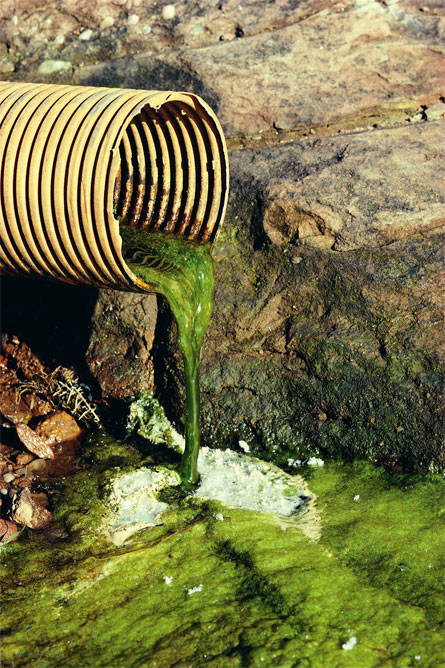
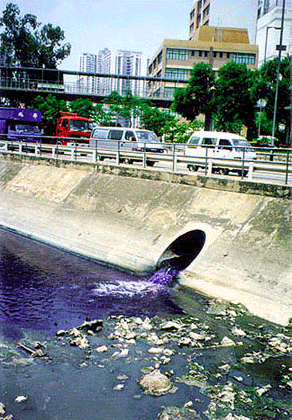
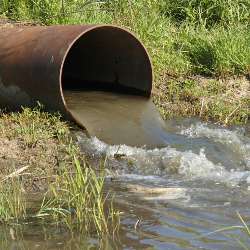
Water pollution occurs when pollutants are discharged directly or indirectly into water bodies without adequate treatment to remove harmful compounds. It has been suggested that it is the leading worldwide cause of deaths and diseases, and that it accounts for the deaths of more than 14,000 people daily. There is no ocean or sea which is not used as a dump. Many seas are used for dumping industrial and nuclear waste. It poisons and kills fish and sea animals.
Many rivers and lakes are poisoned too
Fish and reptiles can’t live in the polluted water. There is not enough oxygen in the water. In such places all the birds leave their habitats and many plants die. Chemicals carried by industrial wastewaters kills a lot of smaller aquatic animals such as frogs, fish etc. This causes a loss of food source for bigger aquatic creatures, leading them to either consume poisoned, dead fish and perish, or leave their natural habitat to go in search of food in other aquatic quarters.
The anthropogenic impact on Baikal has significantly risen since the 1950s. Industrial and civil building has grown and spread, the population has grown and new towns and settlements have arisen, new lands have been ploughed up and more chemicals have been used in agriculture. Today the greatest threat of pollution to the lake is posed by two sources - the town of Ulan-Ude and the Baikal Pulp and Paper Plant (BPPP). There are different opinions about water pollution in Baikal.
An oil spill is the release of a liquid petroleum hydrocarbon into the environment, especially marine areas, due to human activity. Cleanup and recovery from an oil spill is difficult and depends upon many factors, including the type of oil spilled, the temperature of the water (affecting evaporation and biodegradation), and the types of shorelines and beaches involved. Spills may take weeks, months or even years to clean up.
Animals that rely on scent to find their babies or mothers fade away due to the strong scent of the oil. This causes a baby to be rejected and abandoned, leaving the babies to starve and eventually die. Oil can impair a bird's ability to fly, preventing it from foraging or escaping from predators.
Industries that generate wastewater with high concentrations of conventional pollutants, toxic pollutants or other nonconventional pollutants need specialized treatment systems. Wastewater from cities can contain a mixture of chemical and biological pollutants. In low-income countries, there are often high levels of pathogens from excreta, while in emerging nations, where industrial development is outpacing environmental regulation; there are increasing risks from inorganic and organic chemicals..
Water pollution affects human health in disastrous ways. Various organizations are constantly trying to clean corrupted water bodies to meet the demand of the ever growing multitude. There are numerous waterborne diseases that are a direct result of water pollution. Ingestion of poorly treated water can cause Diarrhea, Cholera, Stomach infections and Typhoid.
We must remember one thing. We have a limited supply of water. And if we continue to pollute available water, it will most definitely lead to disease and death. Yes, there's still a lot we can do. If we work hard to conserve our wetlands and rivers - the source of our drinking water - there's hope for a brighter future.
Deforestation
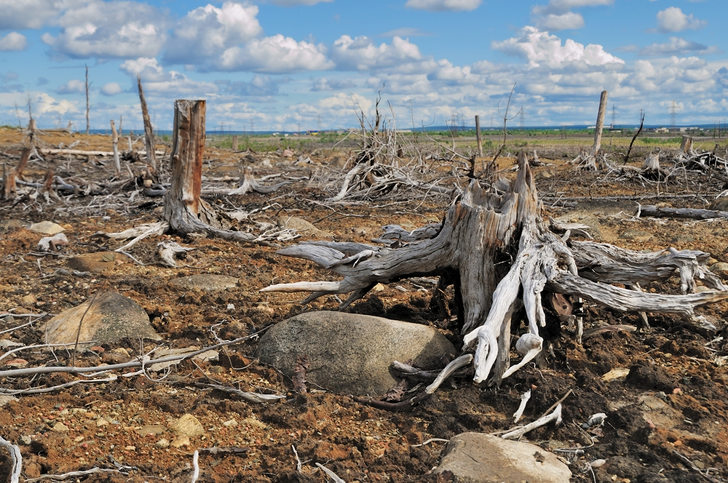
Deforestation is the main ecological problem nowadays. Forests are cut down for many reasons, but most of them are related to money or to people’s need to provide for their families. The biggest driver of deforestation is agriculture. Logging operations, which provide the world’s wood and paper products, also cut countless trees. Forests are also cut as a result of growing urban sprawl.
Deforestation has many negative effects on the environment. Large cities with numerous industrial enterprises appear all over the world. Every year world industry pullets the atmosphere with tons of dust and other harmful substances. People from many cities suffer from smog. Forests are disappearing and this upsets the oxygen balance. The most dramatic impact is a loss of habitat for millions of animals. Seventy percent of Earth’s land animals and plants live in forests, and many cannot survive the deforestation that destroys their homes.
Fires are a natural and beneficial element of many forest landscapes. Each year, millions of areas of forest around the world are destroyed by fire. Causes of forest fires According to forest fire statistics, 9 out of 10 forest fires are of human-caused origin.
The main causes of forest fires are: Agricultural activities like burning grass-gorse or stubble.
a. Throwing of burning cigarettes end or matches.
b. Lighting of fires in restricted areas.
c. Burning of wastes and garbage at non-authorized landfill sites.
d. Military exercises.
e. Hunting activities.
f. Residential activities like the use of electrical tools that cause sparks and burn of wastes.
g. Arson.
h. Short-circuit of power lines.
i. Lightings.
Impacts of forest fires. Forest fires don't just have an impact on the environment, but on economy, society, and human health. Forest fires leave a visual impact, causing damage to houses and other properties, environmental destruction, damage to local and national economies and the potential for loss of life.
Recovery time of a forest after clearing and a burn. Note that it is only after 100+ years that forest become as they were before the cut. Forest regrowth sequesters atmospheric carbon as plant biomass.
So what can you do about deforestation?
One easy way to combat deforestation is to plant a tree. Here’s what you can do:
1. Plant a tree.
2. Go paperless.
3. Recycle and buy recycled products.
4. Look for Forest Stewardship Council (FSC) certification on wood and wood products.
5. Eat vegetarian meals as often as possible.
Litter
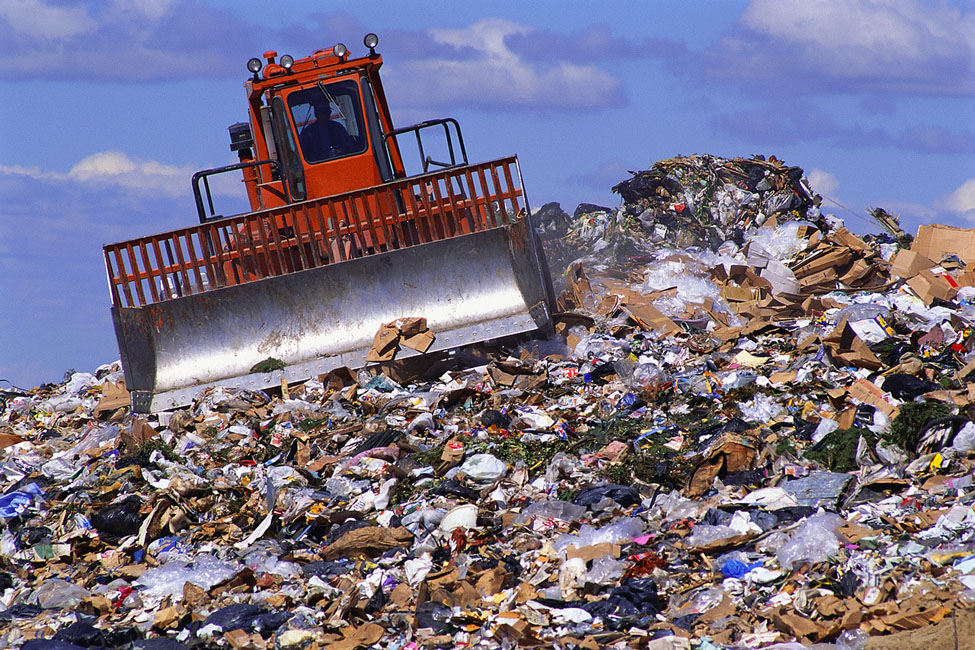
Our society is producing too much parading and food waste which are dropped in the street or end up on the rubbish tip; diseases spread more easily.
Litter can cause dirty street, spread of diseases.
The government should encourage recycling, use litter bins.
Urban sprawl
The problem of urban sprawl is caused by growing cities. As a result, animals are losing their habitats. Population growth is the main of global problems. Population growth expresses the total result of all economic, social and cultural activities.
World population grows every day by 250 thousand. The growth rate is increasing and already so large (approaching 100 million a year), that it became characterized as a population explosion that can shake the planet. It was a steady increase in population requires ever-increasing food production and energy consumption of mineral resources and leads to increased pressure on the biosphere.
The government should conduct population policy!
Global warming
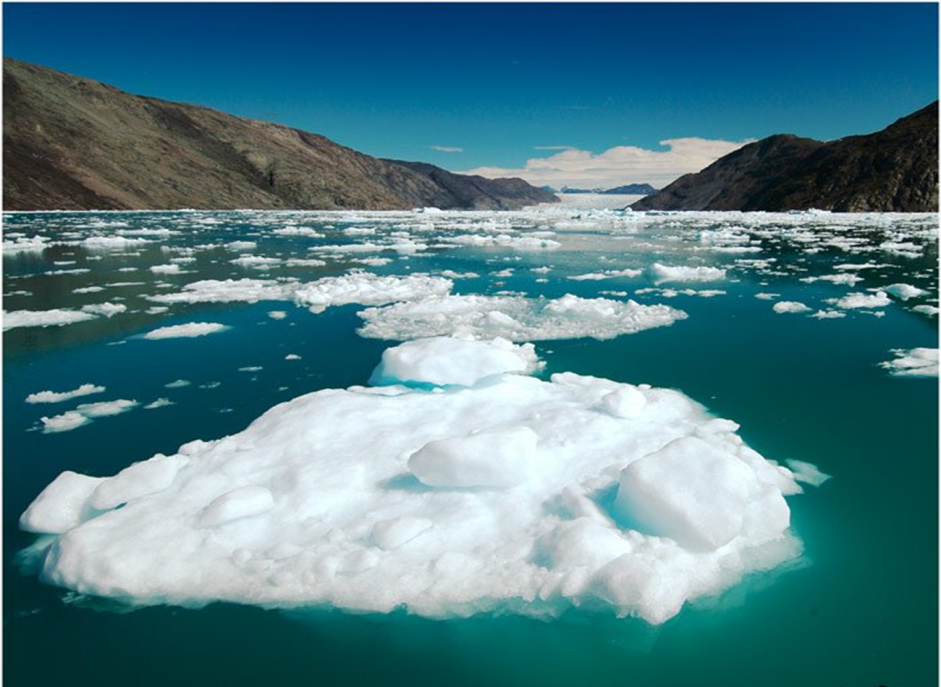
Global warming is the rise in the average temperature of Earth's atmosphere and oceans since the late 19th century and its projected continuation. Since the early 20th century, Earth's mean surface temperature has increased by about 0.8 °C. Warming of the climate system is certain, and scientists are more than 90% certain that it is primarily caused by increasing concentrations of greenhouse gases produced by human activities such as the burning of fossil fuels and deforestation These findings are recognized by the national science academies of all major industrialized nations.
Warming and related changes will vary from region to region around the globe The effects of an increase in global temperature include a rise in sea levels and a change in the amount and pattern of sludge, as well a probable expansion of subtropical deserts. Warming is expected to be strongest in the Arctic and would be associated with the continuing retreat of glaciers, permafrost and sea ice. Other likely effects of the warming include a more frequent occurrence of extreme-weather events including heat waves, droughts and heavy rainfall, ocean acidification and species extinctions due to shifting temperature regimes. Effects significant to humans include the threat to food security from decreasing crop yields and the loss of habitat from flood.
Temperature changes vary over the globe. Since 1979, land temperatures have increased about twice as fast as ocean temperatures (0.25 °C per decade against0.13 °C per decade). Ocean temperatures increase more slowly than land temperatures because of the larger effective heat capacity of the oceans and because the ocean loses more heat by evaporation. The northern hemisphere warms faster than the southern hemisphere because it has more land and because it has extensive areas of seasonal snow and sea-ice cover subject to ice-albedo feedback. Although more greenhouse gases are emitted in the Northern than Southern Hemisphere this does not contribute to the difference in warming because the major greenhouse gases persist long enough to mix between hemispheres.
Greenhouse gases
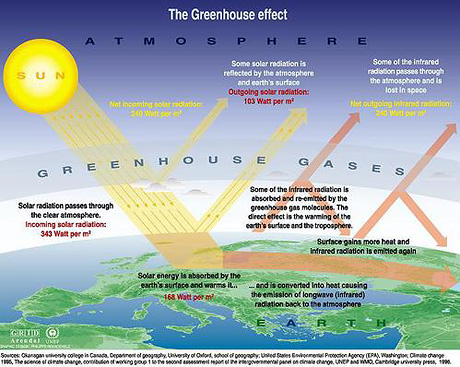
The greenhouse effect is the process by which absorption and emission of infrared radiation by gases in the atmosphere warm a planet's lower atmosphere and surface.
Human activity since the Industrial Revolution has increased the amount of greenhouse gases in the atmosphere, leading to increased radiation. Less direct geological evidence indicates that carbon dioxide values higher than this were last seen about 20 million years ago.. The rest of this increase is caused mostly by changes in land-use, particularly deforestation.
Over the last three decades of the 20th century, gross domestic product per capita and population growth were the main drivers of increases in greenhouse gas emissions. CO2 emissions are continuing to rise due to the burning of fossil fuels and land-use change.
Changes in regional climate are expected to include greater warming over land, with most warming at high northern latitudes, and least warming over the Southern Ocean and parts of the North Atlantic Ocean. Snow cover area and sea ice extent are expected to decrease, with the Arctic expected to be largely ice-free in September by 2037.
Pollution
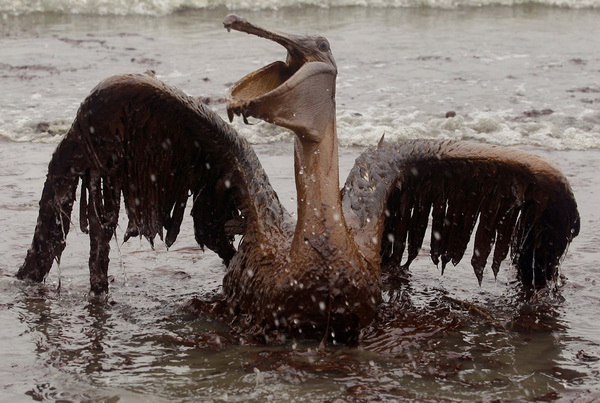
Oil Spills have a devastating effect on our oceans that can last years or even decades. Wildlife and the ecosystems they are a part of suffer tragically under the toxic burden of these human-caused accidents. The problem is a global one that increasingly threatens already fragile ecosystems. For example, on November 7, 2007 the cargo freighter Cosco Busan struck the Bay Bridge in San Francisco Bay, California, tearing a 90-foot-long gash in its hull and spilling 58,000 gallons of fuel into the bay. Three days later, a storm wrecked several ships in the Kerch Strait between the Black Sea and the Sea of Azov, including a tanker that spilled more than a half million gallons of oil.
Technological waste not recycled and not landfilled are traded and resume the road in general for some countries such as China, India, Ghana, Nigeria ... Here, these result in huge waste dumps open in which people living there trying to recover everything that is possible to be in conditions disregarding any notion of safety or health. It is not necessarily useful to clarify after reading paragraphs previous levels of health, disease, and mortality records fight here.
As seen in the photo, this albino snake was born with two heads. The strange feature for such snake is that its two separate mouths were connected to the same stomach. When this news spread, it quickly drew the attention of environmental experts. New research identifies that such deformities have been caused partly due to runoff from farming and ranching. This conclusion was supported by the study of a University of Colorado, as they agreed that the growing number of deformed snake were primarily caused by the nutrient-rich runoff from farming and ranching as indicated by the new research
The destruction of forests

Forests are very important to the environment because they use carbon dioxide (CO2) and produce oxygen. They also provide shelter and food for many different types of plants and animals. Trees are cut down for many reasons but the main reasons are to make space to build new houses and to clear land to grow grass for cows and sheep to eat, to produce dairy foods. Cutting down trees is called deforestation and it can have serious effects. If animals’ homes, which are built in and around the trees, are destroyed, many species will become extinct. Deforestation also affects the climate. When rain falls on a forest, new clouds are created. If huge areas of trees are cut down, clouds do not form, rain does not fall and the land becomes drier. We can help to save forests by reusing and recycling paper.
Each year the sea near the Faroe Islands in the north of Europe to become red. The water is stained with blood of hundreds of whales killed by local residents Nov. 22 during the annual whaling festival called Grindadrap. Whaling is not for commercial purposes - the meat cannot be sold, but you can only split evenly between members of the local community. Hunters chase whales in the bay, then interrupt them ridge, leaving bleeding directly into the water. The sea becomes literally red that gives a little pleasure locals witnessed this process.
Every year in the world, for the sake of the fur, kill millions of animals. Fur animals bred for fur farms, where they live in small cages, and then kill them either by injecting venom, or by electric shock. The death of the animals living in the wild, too, is hardly humane - they are caught by traps or traps, and then another shot to finish off a live animal in the eye or sticks - that skin is left intact. Community organizations that protect the rights of animals, always arrange shares advises against killing our little for the sake of real fur.
Ecological Organizations

People are beginning to realize that environmental problems are not somebody else’s. They join and support various international organizations and “green” parties. In 1987 “Green Peace” public commission was set up. Its main goal is nature conservation. Another area of its work is set up and strengthens cooperation among environmentalists from many similar organizations abroad. “Travel for Peace and Nature” is a public movement, which appeared in Russia some years ago. The movement uses all kinds of environmental actions and informs the public of the ways, means and results of this work.
It’s very important to support ecological organizations as their initiatives, protests and proposals help to persuade government to make the right decision and help them to reach a compromise between the benefits of industry and dangers to the environment in which we live.
The more proposals, the more care of the environment. Much depends on individuals whose care for clean parks and streets is also a contribution to a healthy life on the earth.
Greenpeace is a non-governmental environmental organization with offices in over forty countries and with an international coordinating body in Amsterdam, the Netherlands. Greenpeace states its goal is to "ensure the ability of the Earth to nurture life in all its diversity" and focuses its campaigning on worldwide issues such as global warming, deforestation, overfishing, commercial whaling, genetic engineering, and anti-nuclear issues. Greenpeace uses direct action, lobbying and research to achieve its goals. The global organization does not accept funding from governments, corporations or political parties, relying on 2.9 million individual supporters and foundation grants.
The Global Environment Facility (GEF) unites 182 member governments — in partnership with international institutions, nongovernmental organizations, and the private sector — to address global environmental issues. An independent financial organization, the GEF provides grants to developing countries and countries with economies in transition for projects related to biodiversity, climate change, international waters, land degradation, the ozone layer, and persistent organic pollutants.
The European Environment Agency (EEA) is an agency of the European Union (EU). Its task is to provide sound, independent information on the environment. It is a major information source for those involved in developing, adopting, implementing and evaluating environmental policy, and also the general public.
The World Wide Fund for Nature (WWF) is an international non-governmental organization working on issues regarding the conservation, research and restoration of the environment, formerly named the World Wildlife Fund, which remains its official name in Canada and the United States. It is the world's largest independent conservation organization with over 5 million supporters worldwide, working in more than 100 countries, supporting around 1,300 conservation and environmental projects. The group says its mission is "to halt and reverse the destruction of our environment". Currently, much of its work focuses on the conservation of three biomes that contain most of the world's biodiversity: forests, freshwater ecosystems, oceans and coasts. Among other issues, it is also concerned with endangered species, pollution and climate change.
2013 was announced to become the Year of Environmental Protection in Russia. Dmitriy Medvedev said: "Everybody understands how much depends on the state of the environment. Environmental issues influence living standards, the state of the outside world, life span. But I would like to draw your attention to something. Some ten years ago, as I remember, the problems of environmental protection were not a priority for us, but even caused some indignation: “Feed us first, then tackle the environment.” Now things have changed completely. Now everyone pays attention to environmental issues – the state, public structures, opinion leaders, and representatives of oppositional political forces. And this is normal. This is global practice and we are already close to that level of concern."

Нравится материал? Поддержи автора!
Ещё документы из категории английский язык:
Чтобы скачать документ, порекомендуйте, пожалуйста, его своим друзьям в любой соц. сети.
После чего кнопка «СКАЧАТЬ» станет доступной!
Кнопочки находятся чуть ниже. Спасибо!
Кнопки:
Скачать документ